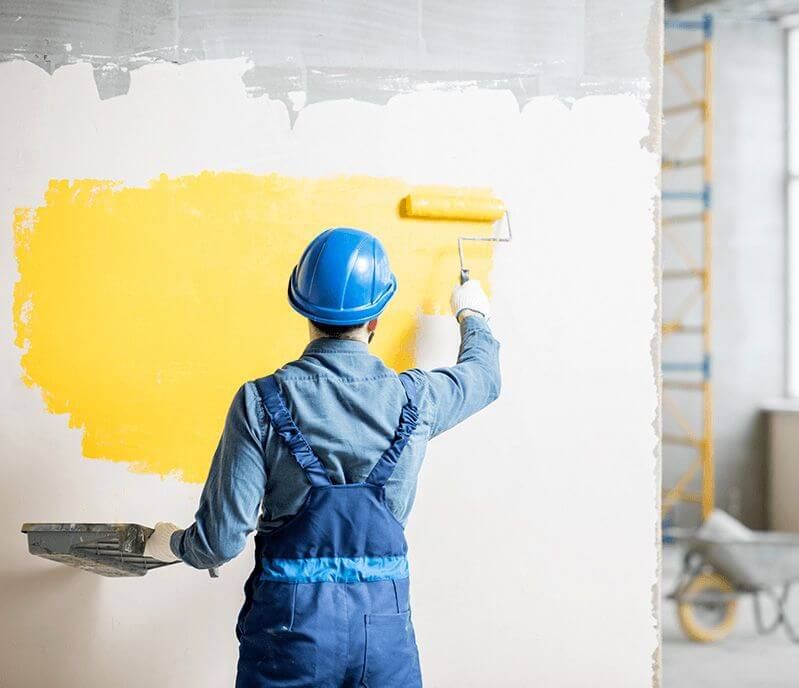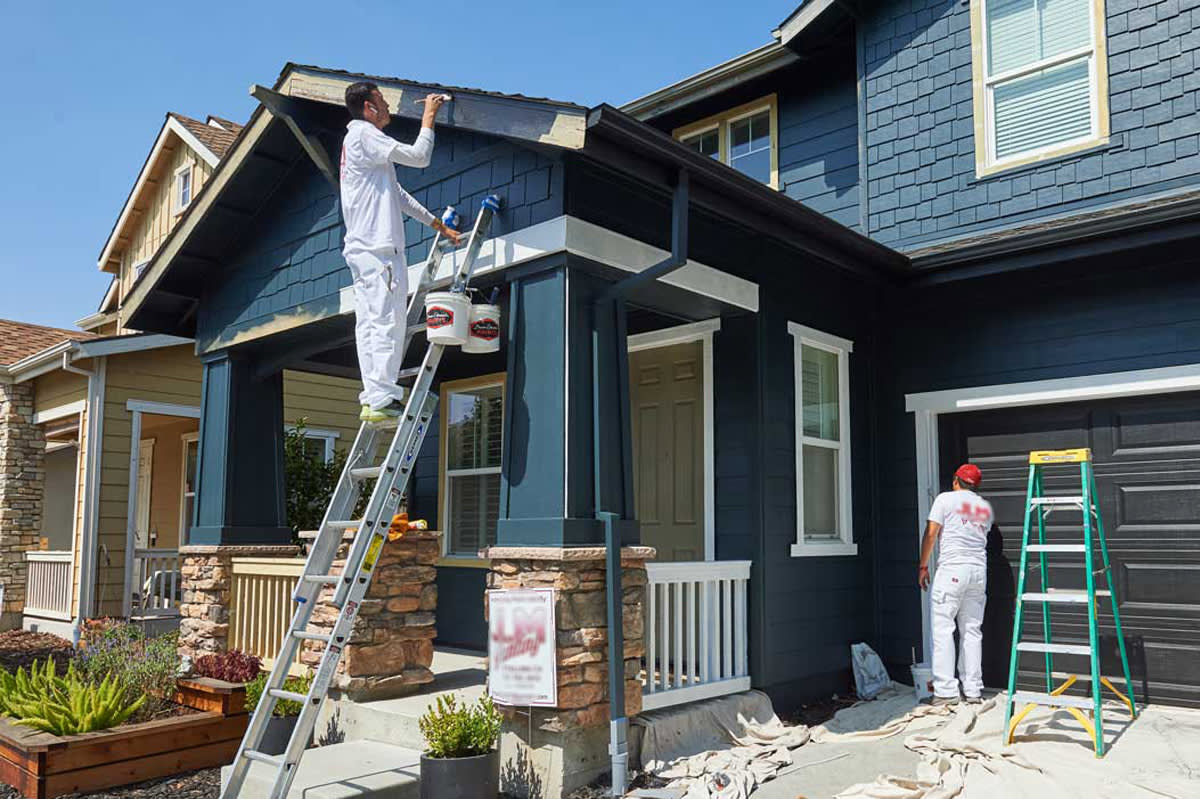Exploring the Various Kinds of Paint: An Overview for every single Task
Discovering the numerous sorts of paint is crucial for attaining the wanted end result in any type of project. From water-based alternatives that supply comfort to oil-based paints understood for their toughness, each option has its benefits. Specialized paints can add unique appearances or coatings, while environment-friendly options deal with those looking for sustainability. Comprehending these distinctions can greatly influence the success of a painting undertaking. What aspects should one think about when making the right option?
Comprehending Paint Types: Oil-Based vs. water-based
Paint types can significantly impact a task's result, and understanding the distinctions between oil-based and water-based paints is vital for educated decision-making. Water-based paints, typically described as latex paints, are made up of water as the key solvent. They dry rapidly, emit less volatile organic substances (VOCs), and are very easy to clean up with soap and water. This makes them a preferred choice for indoor applications and settings where air quality is a concern.
In comparison, oil-based paints make use of organic solvents, supplying a durable, glossy coating perfect for surface areas subjected to tear and wear, such as trim and cupboards. They take longer to completely dry, require mineral spirits for clean-up, and have a more powerful smell. paint shops in corpus christi. Picking in between these two types depends upon the details needs of the project, thinking about variables such as desired finish, application atmosphere, and simplicity of upkeep. Each kind has distinctive advantages and limitations, assisting the option procedure
The End Up Issues: Picking Between Matte, Satin, and Gloss
When selecting a paint finish, the choice between matte and glossy choices considerably influences both visual appeals and functionality. Matte finishes provide a subtle, non-reflective look that can hide surface imperfections, while glossy coatings give durability and ease of cleaning. Understanding the advantages and factors to consider of each can aid in making an educated choice for any type of paint job.
Matte Complete Benefits
Lots of house owners dispute the advantages of various coatings, matte paint supplies distinctive advantages that make it a popular selection for both indoor and exterior applications. One of the key benefits of matte finish is its capacity to hide surface area flaws, creating a smoother look on wall surfaces. This high quality is particularly helpful in older homes or spaces with unequal surfaces. Additionally, matte paint absorbs light instead of showing it, which can boost the aesthetic of an area by supplying a more innovative and soft appearance. Additionally, matte finishes are frequently easier to repair than glossier options, as they can blend much more seamlessly when used over existing paint. Generally, matte paint is an excellent option for those looking for a refined and elegant finish.
Shiny End Up Considerations
A glossy coating can significantly change the assumption of a space, using a reflective and sleek high quality that enhances both shade vibrancy and light within a room. This surface is commonly preferred for high-traffic areas and surface areas like bathroom and kitchens, where durability and ease of cleaning are necessary. Its reflective nature can highlight blemishes on walls, making appropriate surface preparation important. Glossy paints likewise have a tendency to reveal spots and finger prints a lot more conveniently, demanding normal upkeep. In addition, lights plays a substantial duty; in intense settings, a glossy surface may create glare, affecting the general aesthetic. Mindful factor to consider of the certain application and atmosphere is important when choosing a shiny surface for any task.
Specialty Paints: When to Utilize Textured or Chalk Paint
Specialty paints, such as distinctive and chalk paint, deal unique visual and sensible advantages that can boost numerous surfaces. Textured paint is perfect for creating deepness and dimension on walls, hiding flaws while including a three-dimensional feeling. It is particularly advantageous in high-traffic locations where toughness and visual passion are crucial.

Both types of specialty paints can transform spaces, yet picking the appropriate one relies on the wanted result and surface area demands. Textured paint may suit bigger locations, while chalk paint can rejuvenate smaller items, showcasing creativity and individual design in any kind of job.
Outside Paints: Safeguarding Your Surfaces From the Components
Exterior paints are crucial for securing surfaces against numerous climate condition. Understanding their climate resistance attributes, proper surface prep work demands, and efficient application techniques can considerably improve sturdiness and performance. This area will certainly describe key factors to consider for picking and making use of outside paints effectively.
Climate Resistance Features
Climate resistance is a crucial attribute of outdoor paints, as it determines exactly how well surfaces can hold up against the extreme elements of nature. High-grade outside paints are formulated to stand up to damages from UV rays, moisture, and temperature level changes. UV resistance guarantees shades remain dynamic in time, protecting against fading and discoloration. Dampness resistance secures against mold and mildew and mildew, which can compromise the honesty of surfaces. Furthermore, paints with superb temperature resistance Recommended Site can expand and acquire without breaking, preserving their protective top qualities. When choosing outside paints, it is crucial to take into consideration these weather condition resistance attributes, as they contribute to the longevity and durability of coloured surface areas, making particular they remain visually pleasing and practical regardless of direct exposure to the elements.
Surface Preparation Demands
Appropriate surface area prep work is a basic action in achieving the very best results with outside paints. To assure ideal adhesion and sturdiness, surface areas need to be extensively cleansed, getting rid of oil, mold, and dirt. This can be accomplished using a pressure washer or a scrub brush with a suitable cleaning service. Once cleaned, surfaces should be inspected for any peeling or flaking paint, which must be scraped away to develop a smooth structure. Fixing any type of holes or splits is additionally essential, as these can permit dampness infiltration. Furthermore, sanding harsh locations promotes better paint adhesion. Finally, using a guide suited for outdoor usage can improve the paint's performance, guaranteeing a long-lasting finish that holds up against the components. Correct preparation is key to an effective outside paint job.
Application Techniques Tips
While using outside paints, it is necessary to make use of efficient techniques that assure surfaces are well-protected versus the elements. Initially, choose the appropriate day for painting; low moisture and mild temperature levels enhance adhesion and drying. Prepping the surface extensively-- cleaning, fining sand, and priming-- ensures much better paint attachment and resilience. Utilizing high-quality brushes or rollers can offer a smoother surface, while spray painting might cover large locations efficiently. Using paint in slim, even layers prevents drips and runs. It is advisable to follow maker guidelines regarding drying out times in between layers. Confirm appropriate air flow during application to help with drying and lessen direct exposure to fumes. These techniques significantly improve the long life and performance of outdoor paint.
Eco-Friendly Options: Low-VOC and Zero-VOC Paints
As consumers end up being progressively familiar with the ecological influence of their selections, low-VOC and zero-VOC paints have emerged as popular options. These paints are developed their explanation to consist of less unpredictable natural compounds (VOCs), which are chemicals that can evaporate into the air and add to air pollution and health issue. Low-VOC paints normally have a minimal quantity of VOCs, while zero-VOC paints have minimal degrees, making them much safer for both outdoor and indoor use.
The benefits of using low-VOC and zero-VOC paints extend beyond ecological factors to consider; they additionally boost interior air high quality, minimizing the danger of breathing issues and allergic responses. Numerous suppliers currently provide a variety of shades and surfaces in environment-friendly choices, making it simpler for customers to locate appropriate items for their projects. By selecting these paints, people can contribute to a healthier setting while still achieving the aesthetic they want in their rooms.
Tools and Techniques for a Flawless Application
Attaining a perfect paint application requires the right devices and methods, which can greatly boost the outcome. Selecting the ideal brush or roller is necessary; brushes work well for sides and intricate locations, while rollers cover larger surface areas effectively. Utilizing premium products ensures much better paint distribution and reduces touches. For ideal outcomes, surface preparation is essential. This consists of cleansing, fining sand, and priming surface areas to advertise attachment.
Strategy likewise plays a significant function. The "W" approach with a roller helps to evenly disperse paint, while long, smooth strokes with a brush protect against visible lines. Functioning in sections permits for better control and mixing. In addition, applying thin layers is preferable to thick layers, minimizing the threat of drips and unequal appearances. Finally, preserving a wet side during application helps accomplish smooth changes between areas. By combining these tools and methods, one can accomplish a sleek and specialist finish.
Tips for Maintaining and Caring for Your Painted Surfaces
Appropriate upkeep and treatment of coloured surface areas can greatly extend their lifespan and maintain their look. Regular cleaning is vital; using a soft cloth or sponge with mild soap and water can remove dust and dust without harming the paint. It is suggested to avoid abrasive cleansers or scrubbing pads, as these can scratch the surface. Furthermore, applying a fresh coat of paint every few years can protect and rejuvenate the color versus wear.
For exterior surface areas, evaluating for indicators of peeling off or fading consistently is necessary. Without delay resolving any kind of problems stops additional damage. In areas prone to dampness, such as shower rooms, utilizing mold-resistant paint and guaranteeing proper air flow can aid preserve the stability of the paint. Utilizing safety finishes can shield versus UV rays and discolorations, making sure that painted surface areas continue to be vibrant and attractive for years to come, inevitably improving the general visual of the room.
Visual Often Asked Questions
Can I Mix Different Kind Of Paint With Each Other?
Mixing various sorts of paint is generally not recommended, official statement as it can result in problems like bad attachment, inconsistent appearance, or unforeseen chain reaction. It's ideal to utilize suitable paints for ideal outcomes and longevity.

How Do I Appropriately Store Leftover Paint?
To properly keep remaining paint, secure the container firmly, label it with the date and shade, and maintain it in a great, completely dry area away from direct sunlight and severe temperatures for suitable conservation.
What Is the most effective Means to Dispose of Extra Paint?
The ideal method to get rid of unused paint is to examine regional policies, as several areas have actually marked harmful waste facilities. Consider giving away functional paint to community organizations or schools for their jobs.
Just How Can I Inform if Paint Is Still Great to Utilize?
To establish if paint is still great, analyze its smell, shade, and consistency. If it appears separated, has an unpleasant odor, or reveals significant modifications in texture, it's most likely no longer usable.
Are There Age Restrictions for Getting Paint Products?
In many regions, there are no details age restrictions for acquiring paint items. Nevertheless, some shops may need clients to be a minimum of 18 years of ages, particularly for products including solvents or dangerous materials.
Paint types can noticeably affect a project's result, and recognizing the distinctions between water-based and oil-based paints is crucial for informed decision-making. Water-based paints, usually referred to as latex paints, are composed of water as the primary solvent. In comparison, oil-based paints use natural solvents, offering a resilient, glossy surface perfect for surfaces subjected to tear and use, such as trim and cupboards. Specialized paints, such as distinctive and chalk paint, offer special visual and useful advantages that can boost various surfaces. In locations prone to moisture, such as shower rooms, making use of mold-resistant paint and making certain correct ventilation can aid keep the stability of the paint.